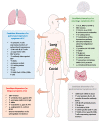Laboratory Findings and Biomarkers in Long COVID: What Do We Know So Far? Insights into Epidemiology, Pathogenesis, Therapeutic Perspectives and Challenges
- PMID: 37445634
- PMCID: PMC10341908
- DOI: 10.3390/ijms241310458
Laboratory Findings and Biomarkers in Long COVID: What Do We Know So Far? Insights into Epidemiology, Pathogenesis, Therapeutic Perspectives and Challenges
Abstract
Long COVID (LC) encompasses a constellation of long-term symptoms experienced by at least 10% of people after the initial SARS-CoV-2 infection, and so far it has affected about 65 million people. The etiology of LC remains unclear; however, many pathophysiological pathways may be involved, including viral persistence; a chronic, low-grade inflammatory response; immune dysregulation and a defective immune response; the reactivation of latent viruses; autoimmunity; persistent endothelial dysfunction and coagulopathy; gut dysbiosis; hormonal and metabolic dysregulation; mitochondrial dysfunction; and autonomic nervous system dysfunction. There are no specific tests for the diagnosis of LC, and clinical features including laboratory findings and biomarkers may not specifically relate to LC. Therefore, it is of paramount importance to develop and validate biomarkers that can be employed for the prediction, diagnosis and prognosis of LC and its therapeutic response, although this effort may be hampered by challenges pertaining to the non-specific nature of the majority of clinical manifestations in the LC spectrum, small sample sizes of relevant studies and other methodological issues. Promising candidate biomarkers that are found in some patients are markers of systemic inflammation, including acute phase proteins, cytokines and chemokines; biomarkers reflecting SARS-CoV-2 persistence, the reactivation of herpesviruses and immune dysregulation; biomarkers of endotheliopathy, coagulation and fibrinolysis; microbiota alterations; diverse proteins and metabolites; hormonal and metabolic biomarkers; and cerebrospinal fluid biomarkers. At present, there are only two reviews summarizing relevant biomarkers; however, they do not cover the entire umbrella of current biomarkers, their link to etiopathogenetic mechanisms or the diagnostic work-up in a comprehensive manner. Herein, we aim to appraise and synopsize the available evidence on the typical laboratory manifestations and candidate biomarkers of LC, their classification based on pathogenetic mechanisms and the main LC symptomatology in the frame of the epidemiological and clinical aspects of the syndrome and furthermore assess limitations and challenges as well as potential implications in candidate therapeutic interventions.
Keywords: COVID-19; biomarkers; epidemiology; laboratory; long COVID; pathogenesis; post-COVID; post-COVID syndrome (PCS); post-acute sequelae of SARS-CoV infection (PASC).
Conflict of interest statement
The authors declare no conflict of interest.
Figures


References
-
- WHO Coronavirus (COVID-19) Dashboard. [(accessed on 7 June 2023)]. Available online: https://covid19.who.int/
Publication types
MeSH terms
Substances
LinkOut - more resources
Full Text Sources
Medical
Miscellaneous

